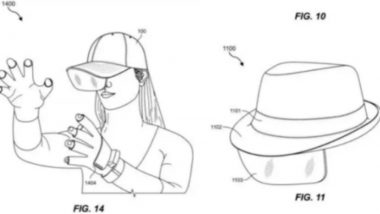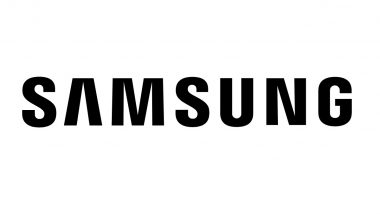According to reports, Facebook published a patent for a baseball cap with a built-in VR/AR headset. This design aims to create applications that allow people to collaborate through augmented reality and virtual reality technologies. The patent depicts a visor that hangs in front of the user's eyes and connects to the cap, and the VR/AR cap headset is also compatible with VR gloves and CTRL-Labs wristbands. What's more, the headset is embedded with an "embedded haptic/brain-machine interface component" and the visor is removable.
Facebook announced its new patent for "AR cap headset"
Facebook designed the headset to quickly enhance the VR/AR user comfort experience, noting that the current system "makes it difficult to integrate advanced computing components such as complex processors and eye-tracking systems'', but it distributes these components in a decentralized fashion instead of a traditional centralized fashion, which will facilitate the heat dissipation and stable operation of computing components and improve user comfort. This is not the first time Facebook has experimented with non-traditional headset designs; back in 2019, Facebook proposed the idea of integrating transmission-enabled components into a portable box.
However, according to the usual practice, the patent application can only show that Facebook is designing a new headset, but cannot prove that the design has been finalized and produced. However,it also reveals that Facebook seeks to break through the product design of Oculus Quest 2, expecting to design a lighter, smaller new generation of headset to improve user wearing comfort. When the headset can be finalized and produced, Facebook will choose some users to start testing the headset, but now the specific operation of the headset has not been revealed, which means it still needs some time to be public.
AR is known to be a technology that cleverly blends virtual information with the real world, and almost all tech giants are currently working on this technology in an attempt to create the next computing platform that will replace mobile phones. But until now, head-mounted AR devices are usually bulky and expensive. For example,the minimum price of Microsoft HoloLens is up to a whopping $3,500. So far, these devices have mainly been for industrial use. Foreign manufacturers Google, Microsoft, Facebook, Intel and Nvidia have invested heavily in the AR field and are very bullish on the AR market. Apple and Facebook are reportedly developing their own AR earphones or glasses to be released in the next few years, which could help make the consumer-facing market viable and create an AR "gold rush.
AR optical waveguide technology is clearly expected to become the mainstream intelligent terminal
AR is expected to become the mainstream smart terminal after mobile phones because flagship tech giants increase their investment and expand their layout in the AR platform. And beyond that, AR can provide users with supplementary or incremental information based on the real environment through images, videos, 3D models and other technologies, so that the application scenarios are richer and more diverse compared to VR devices. Apple has also started to add LiDar cameras to iphones, iPads and other devices to build an application ecosystem for AR live-action interaction. Meanwhile, Samsung demonstrated its AR glasses for the first time in the Gait Enhancing & Motivating System demo at CES 2020.
The imaging effect of AR wear determines the user experience, and the optical system of the lens is the key to determine the imaging effect of AR devices. For example, according to the different optical principles used in AR glasses, the four main common display solutions are prism, free-form surface, Bird-bath and optical waveguide.
The optical waveguide is considered the main solution to meet the imaging needs of AR glasses.It's because the optical waveguide can achieve total reflection of light, that is, after the optical machine completes imaging, the light is coupled into the glass substrate of the waveguide, and then the light is transmitted to the front of the glasses based on the "total reflection" principle, and finally released. The "total reflection" of the optical waveguide ensures clear imaging and high image contrast, while also providing users with a larger FOV.
The optical waveguide can be divided into diffractive waveguide and array optical waveguide.The array optical waveguide lens adopts optical cold processing technology, which can be processed through multiple processes. Diffractive optical waveguides mainly have surface relief grating waveguide scheme and volume holographic grating waveguide scheme. In short, optical waveguide technology has large FOV and wide eye movement range, which brings the double strong effect: AR FOV uniformity and color uniformity.
Meanwhile, domestic AR companies have also achieved breakthroughs in recent years. From entertainment and social AR devices to AR terminals that combine virtuality and reality, WiMi Hologram Cloud has independently developed an AR holographic cloud platform for computer vision and a business ecosystem based on holographic technology applications, so as to maintain a leading position in the industry and create a holographic ecological business model. Specifically, WiMi Hologram Cloud was founded in 2015. WiMi Hologram Cloud focuses on holographic cloud services, which are mainly in the professional fields, such as, onboard AR holographic HUD, 3D holographic pulse LiDAR, head-mounted light field holographic device, holographic semiconductor, holographic cloud software and holographic car navigation. In conclusion, WiMi Hologram Cloud is a holographic cloud comprehensive technical solution provider, covering multiple links of holographic AR technology, and it includes holographic onboard AR technology, 3D holographic pulse LiDAR technology, holographic visual semiconductor technology, holographic software development, holographic AR advertising technology, holographic AR entertainment technology, holographic ARSDK payment, interactive holographic communication, etc.
WiMi Hologram Cloud creates AR collaborative application to build holographic ecological development strategy
Combined with the current 5G commercial era, 5G's ultra-low latency can even bring AR surprises. Through the combination of 5G and AR to achieve remote communication and data transmission, users can access more product information in the platform faster. Under 5G network, WiMi Hologram Cloud believes that AR wearable devices will become the first AR product that can be commercially available on a large scale, and that will be well accepted by the market because of its lightness and wearing comfort.
WiMi HologramCloud announced that it has been awarded a patent for a holographic AR head-mounted display using Retina Scanning Display (RSD) and a flat waveguide technology with semi-permeable array. The head-mounted display optical system will be generated by the computer. The output of holographic AR image source is digitized and holographically imaged in the user's field of view, so as to achieve the simulation technology which reproduces a specific environment.
WiMi Hologram Cloud immersive head-mounted AR display technology has a lot merits, such as large field of view, low power consumption, wearability, modularity, stereoscopic display, and high degree of customization. By virtue of these strengths, WiMi Hologram Cloud has shown great success in telemedicine, industrial construction, environmental simulation, traffic instructions, virtual education, holographic communication, 3D printing, and assisted driving. However, with the maturity of the optical waveguide solution,the process cost decreases.
Therefore, WiMi Hologram Cloud believes that AR headset devices in the form of standalone products are expected to be gradually public in the terminal from 2025, while the ecological construction and product positioning are the keys to accelerate the penetration of AR products in the terminal. Consequently, WiMi Hologram Cloud continues to expand its holographic product portfolio, successively developing patents for 3D holographic pulse laser processing device, "WiMiHoloAR HUD" product, holographic real-time imaging patent with diameter of atomization granule of 2-4μm, etc. In this way, WiMi Hologram Cloud will expand the market of holographic technology applications and accelerate the penetration of AR products in the terminal.
The current value chain of the holographic AR industry consists of three main components. The upstream part refers to the key hardware, software, services and providers and participants related to content production. The midstream participants are holographic AR solution providers, integrating upstream hardware and software systems to form final products or solutions, such as holographic AR advertising platforms and head-mounted displays. The downstream refers to users, including governments, enterprises and individual consumers.
WiMi Hologram Cloud is currently involved in the upstream part and the midstream part, involving developing software, providing content production technology, creating and distributing content and providing holographic AR solution providers. WiMi Hologram Cloud has the leading holographic application platform, which is mainly applied in the entertainment, advertising, film and television industries. Beyond that,WiMi Hologram Cloud has a relatively mature hardware environment, which is very favorable for the development of software and content in these fields.
With the accumulation of time and the maturity of AR technology, WiMi Hologram Cloud AR has been greatly applied in many fields such as medicine, entertainment and commerce. It has five main commercial application scenarios, such as home entertainment, light field theater, performing system, commercial release system and advertising display system. In addition, WiMi Hologram Cloud has the world's leading 3D computer vision technology and SAAS platform-based technology,by which, WiMi Hologram Cloud turns ordinary images into holographic 3D content through AI algorithms, which is widely used in holographic advertising, holographic entertainment, holographic education, holographic communication and other fields.
To illustrate the function of 3D holographic projection, WiMi Hologram Cloud opened the AR cloud platform application, designed an "avatar" to represent itself to join the office meeting, and this "avatar" looks like a hologram. By the captured information, the avatar's head, body and hands can move and it can talk freely with each person, which is especially useful in video calls. Additionally, users can import, display and manipulate ready-made customized 3D holograms, as well as use 3D drawing tools.
WiMi Hologram Cloud plans to integrate AR technology into its own various ecological applications in the future, so as to use artificial intelligence, cloud computing, big data, Internet of Things technology to help enterprises achieve digital transformation.
In terms of hardware market space, the combination of hardware and software further realizes new leaps and strategic breakthroughs for enterprises; in terms of digital life combining reality and virtuality, telecommuting, remote education and teleconferencing are combined with various technologies, such as AR, VR, 5G, to form a strong holographic AR technology R&D ecosystem to drive the huge demand market of the holographic industry and the structural opportunity growth of the science and technology innovation board.
The key points for the future development of WiMi Hologram Cloud seem to be expected. Tailor Insight (www.TailorInsight.com) provides easy and quick solutions that allow customers to capture, monitor, and audit market data from a holistic view down to an individual task on market research and industry trend insights.













 Quickly
Quickly





















